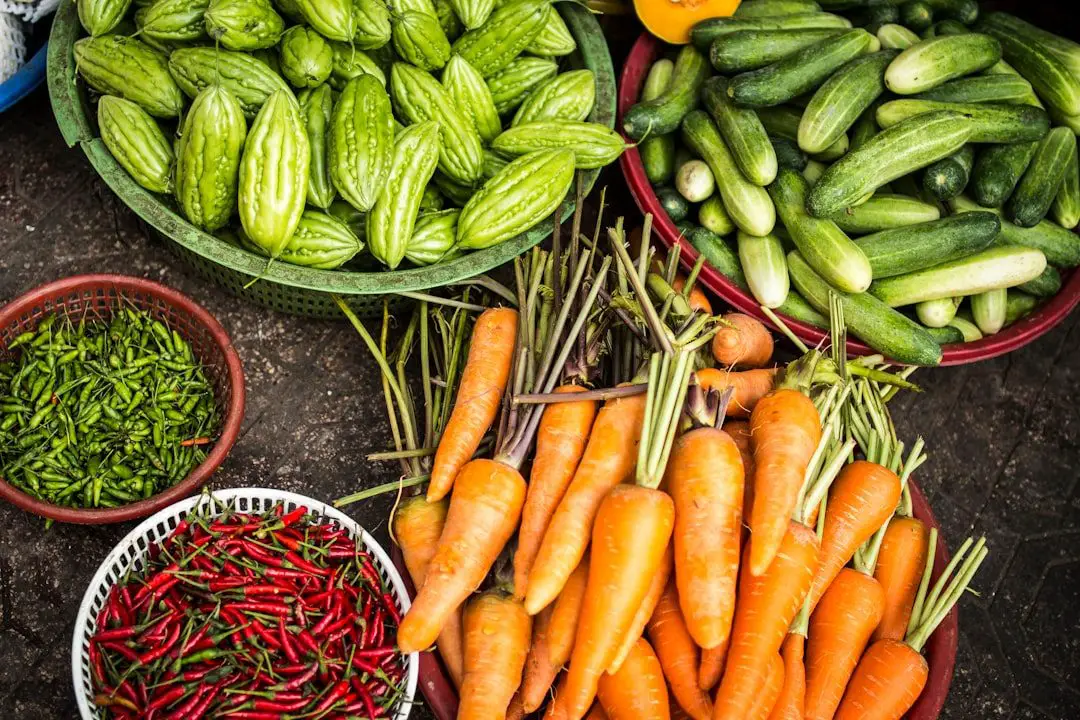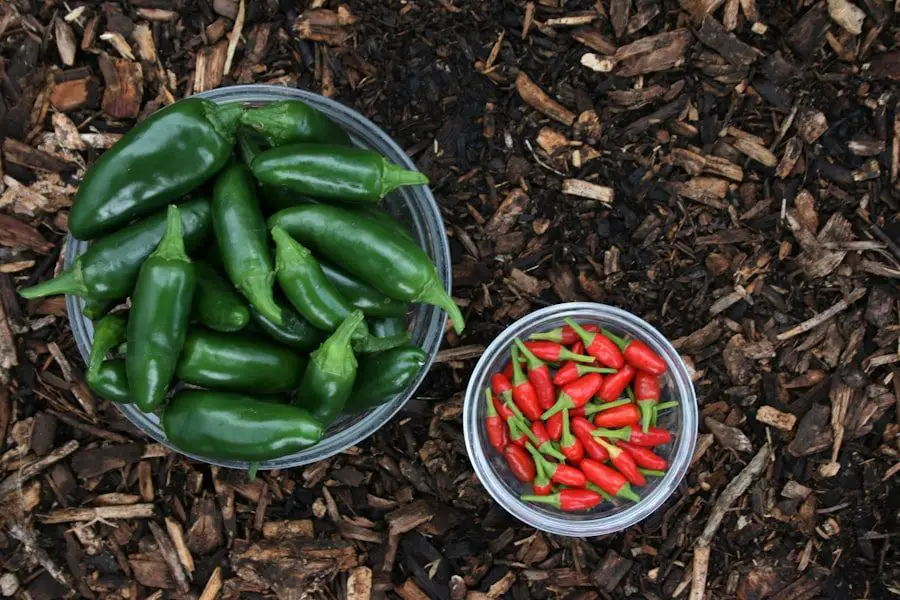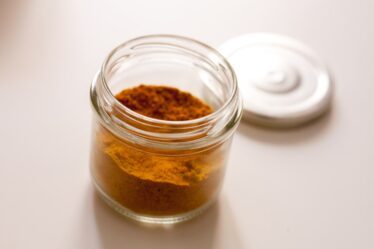
Bird Eye Chili Pepper, also known as Thai Chili or Bird’s Eye Chili, is a small and fiery pepper that is widely used in Southeast Asian cuisine. It is believed to have originated in South America and was brought to Asia by Portuguese traders in the 16th century. The pepper gets its name from its small size and round shape, resembling a bird’s eye.
Bird Eye Chili Pepper is known for its intense heat and pungent flavor. It has a Scoville heat rating of 50,000 to 100,000, making it one of the hottest chili peppers in the world. The flavor profile of Bird Eye Chili Pepper is complex, with fruity and citrusy notes, along with a strong spiciness. It adds a fiery kick to dishes and is often used in curries, stir-fries, and sauces.
Key Takeaways
- Bird Eye Chili Pepper is a small, fiery chili pepper commonly used in Southeast Asian cuisine.
- It has numerous health benefits, including aiding digestion, boosting metabolism, and reducing inflammation.
- Bird Eye Chili Pepper is versatile in the kitchen and can be used in a variety of dishes, from soups and stews to marinades and sauces.
- Growing Bird Eye Chili Pepper at home is easy and requires minimal maintenance.
- Bird Eye Chili Pepper is hotter than most other chili peppers and adds a unique flavor to international cuisines.
Health Benefits of Bird Eye Chili Pepper
Bird Eye Chili Pepper is not only a flavorful addition to dishes but also offers several health benefits. It is rich in vitamins A and C, which are essential for maintaining a healthy immune system and promoting good vision. The pepper also contains minerals such as potassium, iron, and magnesium.
One of the key health benefits of Bird Eye Chili Pepper is its ability to boost metabolism and aid in weight loss. The capsaicin compound found in the pepper has been shown to increase thermogenesis, which is the process of burning calories to produce heat. This can help increase calorie expenditure and promote weight loss.
Capsaicin also has anti-inflammatory properties and can help relieve pain. It works by inhibiting the production of substance P, a neurotransmitter that plays a role in transmitting pain signals to the brain. This makes Bird Eye Chili Pepper a natural remedy for conditions such as arthritis and muscle pain.
Culinary Uses of Bird Eye Chili Pepper
Bird Eye Chili Pepper is a staple ingredient in Southeast Asian cuisine, particularly in Thai, Vietnamese, and Indonesian dishes. It is used to add heat and flavor to a wide range of dishes, including curries, stir-fries, soups, and sauces. The pepper can be used fresh, dried, or powdered, depending on the desired intensity of heat.
In Thai cuisine, Bird Eye Chili Pepper is a key ingredient in dishes such as Tom Yum soup and Green Curry. It adds a spicy kick to these dishes and balances out the flavors. In Vietnamese cuisine, the pepper is used in popular dishes like Pho and Bun Bo Hue. It adds heat and depth of flavor to these dishes.
Bird Eye Chili Pepper can also be used to make spicy sauces and condiments. In Indonesian cuisine, it is used to make Sambal, a spicy chili paste that is served as a condiment with various dishes. The pepper can also be pickled or used to make chili oil.
How to Grow Bird Eye Chili Pepper at Home
| Aspect | Metric |
|---|---|
| Soil | Well-draining soil with pH between 5.5-7.5 |
| Watering | Regular watering, but avoid overwatering |
| Sunlight | Full sunlight for at least 6 hours a day |
| Temperature | Optimal temperature range of 70-90°F |
| Fertilizer | Use a balanced fertilizer every 2-3 weeks |
| Pruning | Pinch off the tips of the plant to encourage bushier growth |
| Pests | Watch out for aphids, spider mites, and whiteflies |
| Harvesting | Harvest when the peppers are fully ripe and red |
If you’re a fan of Bird Eye Chili Pepper and want to grow your own at home, it is relatively easy to do so. The pepper plants require warm temperatures and plenty of sunlight to thrive. Here are some tips for growing Bird Eye Chili Pepper:
– Soil and climate requirements: Bird Eye Chili Pepper plants prefer well-draining soil that is rich in organic matter. They also require a warm climate with temperatures between 70°F and 90°F. If you live in a colder climate, you can grow the plants indoors or in a greenhouse.
– Planting and care instructions: Start by planting the seeds in small pots or seed trays filled with potting soil. Keep the soil moist but not waterlogged. Once the seedlings have grown to a few inches tall, transplant them into larger pots or directly into the ground. Water the plants regularly and provide support for them to climb if needed.
– Harvesting and preserving methods: Bird Eye Chili Pepper plants typically start producing fruit within 2-3 months. Harvest the peppers when they are fully ripe and red in color. You can use them fresh in your cooking or dry them for later use. To dry the peppers, string them together and hang them in a warm, well-ventilated area until they are completely dry. Store the dried peppers in an airtight container.
Bird Eye Chili Pepper vs Other Chili Peppers
Bird Eye Chili Pepper is known for its intense heat, but how does it compare to other chili peppers? Let’s take a look at some popular chili peppers and compare their heat levels and flavor profiles:
– Habanero Pepper: Habanero peppers are known for their extreme heat, with a Scoville rating of 100,000 to 350,000. They have a fruity and floral flavor profile, with a hint of sweetness. Habanero peppers are commonly used in Caribbean and Mexican cuisines.
– Jalapeno Pepper: Jalapeno peppers have a milder heat compared to Bird Eye Chili Pepper, with a Scoville rating of 2,500 to 8,000. They have a bright and grassy flavor profile, with a medium level of spiciness. Jalapeno peppers are commonly used in Mexican cuisine.
– Cayenne Pepper: Cayenne peppers have a similar heat level to Bird Eye Chili Pepper, with a Scoville rating of 30,000 to 50,000. They have a smoky and earthy flavor profile, with a medium level of spiciness. Cayenne peppers are commonly used in Cajun and Creole cuisines.
Each chili pepper has its own unique flavor profile and heat level, making them suitable for different types of dishes and cuisines.
Bird Eye Chili Pepper in International Cuisines

Bird Eye Chili Pepper is a versatile ingredient that is used in various cuisines around the world. Let’s take a look at some examples of dishes from different countries that use Bird Eye Chili Pepper:
– Thai cuisine: In Thailand, Bird Eye Chili Pepper is used in dishes such as Tom Yum soup, Green Curry, and Pad Thai. It adds a spicy kick to these dishes and enhances the flavors.
– Vietnamese cuisine: In Vietnam, Bird Eye Chili Pepper is used in dishes like Pho, Bun Bo Hue, and Banh Mi. It adds heat and depth of flavor to these dishes.
– Indonesian cuisine: In Indonesia, Bird Eye Chili Pepper is used to make Sambal, a spicy chili paste that is served as a condiment with various dishes. It is also used in dishes like Nasi Goreng and Rendang.
– Indian cuisine: In India, Bird Eye Chili Pepper is used in dishes such as Vindaloo, a spicy curry dish from Goa. It adds heat and flavor to these dishes.
Bird Eye Chili Pepper plays a significant role in the culinary traditions of these countries and adds a unique flavor profile to their dishes.
Bird Eye Chili Pepper Recipes for Spicy Food Lovers
If you’re a fan of spicy food, here are some delicious recipes that feature Bird Eye Chili Pepper:
1. Spicy Thai Basil Chicken:
Ingredients:
– 2 tablespoons vegetable oil
– 3 cloves garlic, minced
– 2 bird eye chili peppers, sliced
– 1 lb boneless chicken thighs, cut into bite-sized pieces
– 1 tablespoon fish sauce
– 1 tablespoon soy sauce
– 1 tablespoon oyster sauce
– 1 teaspoon sugar
– 1 cup fresh Thai basil leaves
Instructions:
1. Heat the vegetable oil in a wok or large skillet over medium heat.
2. Add the garlic and chili peppers and stir-fry for 1 minute.
3. Add the chicken and cook until browned and cooked through.
4. In a small bowl, whisk together the fish sauce, soy sauce, oyster sauce, and sugar. Pour the sauce over the chicken and stir to coat.
5. Add the Thai basil leaves and stir-fry for another minute until wilted.
6. Serve hot with steamed rice.
2. Bird Eye Chili Pepper Sambal:
Ingredients:
– 10 bird eye chili peppers
– 3 cloves garlic
– 1 tablespoon lime juice
– 1 teaspoon sugar
– Salt to taste
Instructions:
1. Place the chili peppers, garlic, lime juice, sugar, and salt in a blender or food processor.
2. Blend until smooth.
3. Taste and adjust the seasoning if needed.
4. Transfer the sambal to a jar and store in the refrigerator for up to 2 weeks.
5. Serve as a condiment with grilled meats, rice dishes, or noodles.
3. Mango and Bird Eye Chili Pepper Salad:
Ingredients:
– 2 ripe mangoes, peeled and sliced
– 2 bird eye chili peppers, sliced
– 1 small red onion, thinly sliced
– Juice of 1 lime
– 1 tablespoon fish sauce
– 1 teaspoon sugar
– Handful of fresh cilantro leaves
Instructions:
1. In a large bowl, combine the mangoes, chili peppers, red onion, lime juice, fish sauce, and sugar.
2. Toss gently to combine.
3. Let the salad sit for 10 minutes to allow the flavors to meld together.
4. Garnish with fresh cilantro leaves before serving.
How to Store and Preserve Bird Eye Chili Pepper
To maintain the freshness and flavor of Bird Eye Chili Pepper, it is important to store it properly. Here are some tips for storing and preserving Bird Eye Chili Pepper:
– Fresh peppers: Store fresh Bird Eye Chili Peppers in the refrigerator in a plastic bag or airtight container. They will stay fresh for up to 2 weeks.
– Dried peppers: To dry Bird Eye Chili Peppers, string them together and hang them in a warm, well-ventilated area until they are completely dry. Once dried, store them in an airtight container in a cool, dark place. Dried peppers can last for up to a year.
– Powdered peppers: To make powdered Bird Eye Chili Pepper, grind dried peppers in a spice grinder or blender until they become a fine powder. Store the powder in an airtight container in a cool, dark place. Powdered peppers can last for up to 6 months.
Bird Eye Chili Pepper in Traditional Medicine
Bird Eye Chili Pepper has been used in traditional medicine for centuries due to its various health benefits. It is believed to have antimicrobial, antioxidant, and anti-inflammatory properties. Here are some examples of how Bird Eye Chili Pepper is used in traditional medicine:
– Pain relief: Capsaicin, the compound responsible for the spiciness of Bird Eye Chili Pepper, has been used topically to relieve pain. It is often found in creams and ointments that are applied to the skin to alleviate muscle pain, arthritis, and nerve pain.
– Digestive health: Bird Eye Chili Pepper is believed to aid digestion and relieve gastrointestinal issues such as bloating and indigestion. It stimulates the production of digestive enzymes and increases blood flow to the stomach.
– Respiratory health: The spiciness of Bird Eye Chili Pepper can help clear congestion and relieve symptoms of respiratory conditions such as colds and sinusitis. It acts as a natural decongestant and expectorant.
While traditional medicine has long recognized the health benefits of Bird Eye Chili Pepper, scientific studies have also supported these claims.
Why You Should Try Bird Eye Chili Pepper in Your Cooking
Bird Eye Chili Pepper is not only a flavorful addition to your dishes but also offers several health benefits. It is rich in vitamins and minerals, boosts metabolism, and contains capsaicin, which has anti-inflammatory and pain-relieving properties. Whether you’re a fan of spicy food or looking to add some heat to your dishes, Bird Eye Chili Pepper is a versatile ingredient that can be used in a wide range of cuisines.
From Thai curries to Indonesian sambal, Bird Eye Chili Pepper adds a fiery kick and depth of flavor to dishes. It can be used fresh, dried, or powdered, depending on your preference. Growing Bird Eye Chili Pepper at home is relatively easy, and it can be preserved for later use.
So why not give Bird Eye Chili Pepper a try in your cooking? Not only will it add a burst of flavor to your dishes, but it will also provide you with numerous health benefits. Spice up your meals and explore the world of Bird Eye Chili Pepper today!
If you’re a fan of spicy food, then you’ve probably encountered the fiery bird’s eye chili pepper. But did you know that this small but mighty pepper has more to offer than just heat? In a recent article on Flavorful Sips, they explore the various uses and benefits of bird’s eye chili pepper. From adding a kick to your favorite dishes to its potential health benefits, this article dives deep into the world of this powerful pepper. Check out the article here to learn more about the versatile bird’s eye chili pepper.



